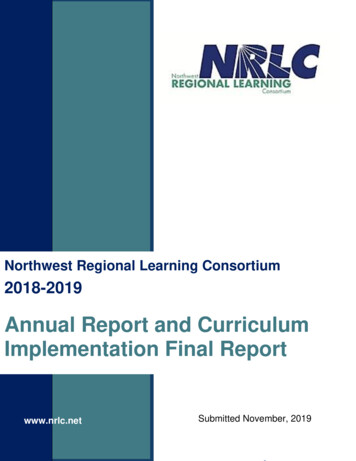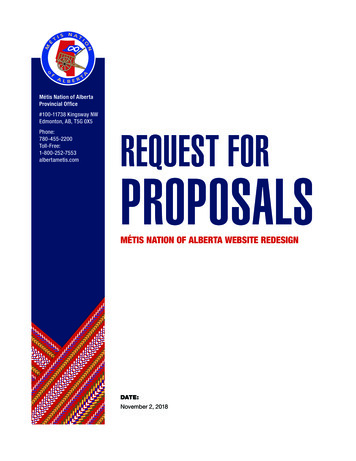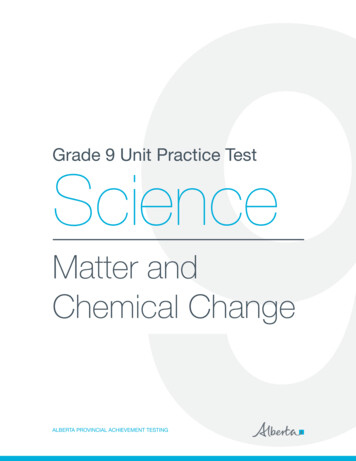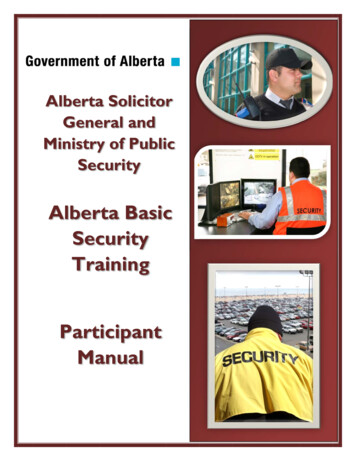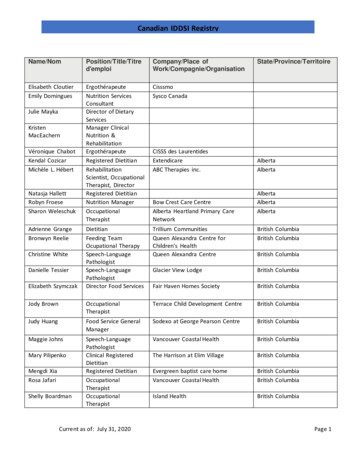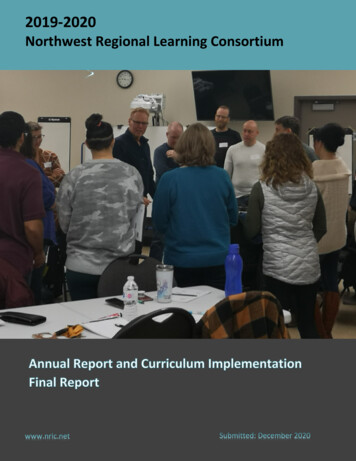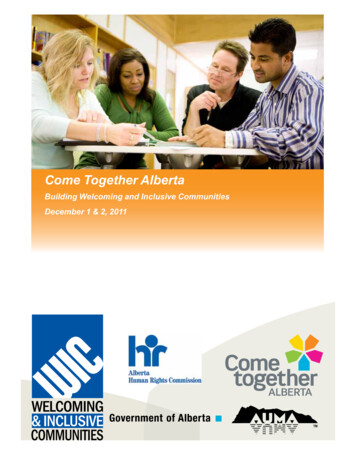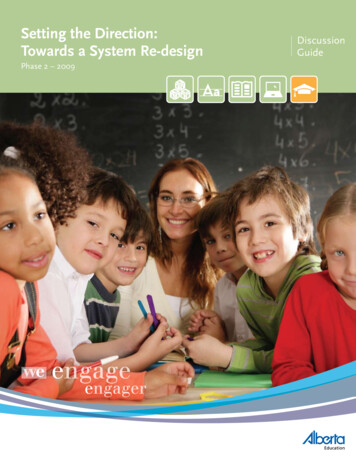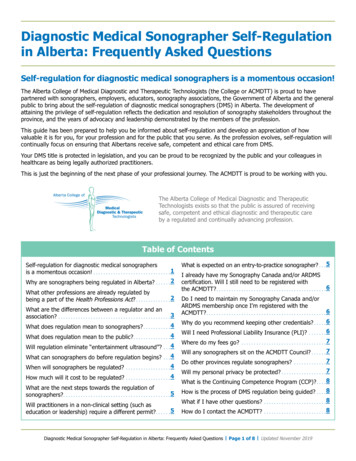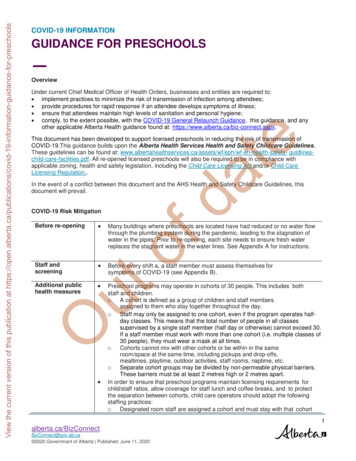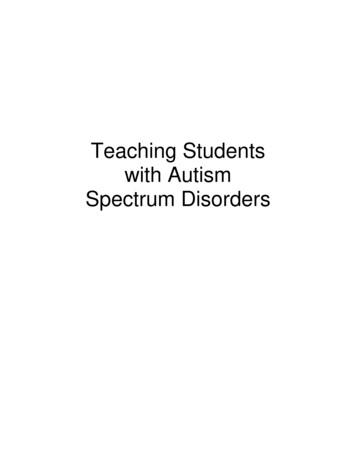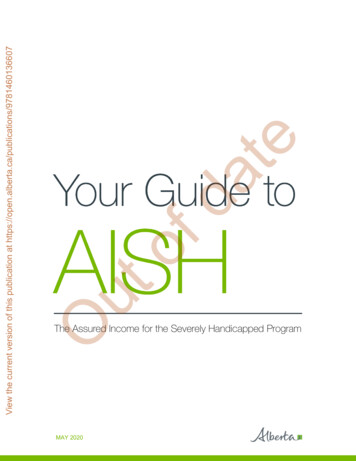
Transcription
OutofdateView the current version of this publication at OkThe Assured Income for the Severely Handicapped ProgramMAY 2020
The AISH program . 3AISH benefits . 4Living allowance . 4Child benefit . 4ofdateHealth benefits . 4Personal benefits . 6AISH eligibility criteria . 8Age and residency criteria . 8Medical criteria . 8Financial criteria . 8Medical eligibility criteria . 9Financial eligibility criteria . 9Income. 9Assets. 15Applying for AISH . 18Understanding the application process . 18Getting a decision about your eligibility. 18Reopening your AISH file . 19Applying for other benefits while waiting . 19AISH payment details . 20OutView the current version of this publication at Table of contentsGetting your payments . 20Reporting changes to AISH . 22Overpayments, underpayments and debts . 24Reasons overpayments and underpayments happen . 24To prevent being overpaid or underpaid . 24When overpayments happen . 24When underpayments happen . 25Appealing an AISH decision . 27Terms and definitions . 28Contact information . 30AISH office locations . 30Other help . 322Your Guide to AISH alberta.ca/aish May 2020
The Assured Income for Severely Handicapped (AISH) program provides financial and healthbenefits to eligible adult Albertans with a permanent medical condition that prevents them fromearning a living.If you are eligible for AISH you may receive:a monthly living allowance – money to pay for your living costs such as food, rent and utilities a monthly child benefit – money to assist you with raising your dependent children health benefits – assistance to cover health needs for you, your spouse or partner and yourofdate dependent children personal benefits – money over and above your monthly living allowance for specific needssuch as a special diet or assistance in an emergencyThis guide will help you learn more about the AISH program and benefits. You can also getinformation from any AISH office listed at the end of this guide, the Alberta Supports ContactCentre, or the AISH Policy Manual at our Guide to AISH contains general information about the Assured Income for the SeverelyHandicapped (AISH) program and reflects what is in AISH legislation, regulations and the AISHPolicy Manual. If there are any differences between what is in this document, the policy manualand the legislation and regulations, the legislation and regulations shall prevail.OutView the current version of this publication at The AISH programMay 2020 Your Guide to AISH alberta.ca/aish3
AISH coverage may include a monthly living allowance, health benefits and personal benefits foryou, your spouse or partner, and your dependent children.Living allowanceofdateStandard living allowanceThis monthly benefit is provided to those who rent or own a home, apartment or condo; live withfamily; live in a private group home; or are homeless. The amount you get depends on any otherincome that you or your spouse or partner may have.Modified living allowanceThis monthly benefit is available for individuals who live in an approved nursing home, auxiliaryhospital or designated supportive living (DSL) facility. The amount you get may depend on otherincome you, or your spouse or partner, may have. The modified living allowances includes apersonal allowance paid to you and an accommodation amount paid directly to the facility.Visit alberta.ca/health-care-facilities to see Alberta’s health facility lists or contact an AISHoffice to find out if your facility is approved for modified AISH.Child benefitYou may also receive a monthly child benefit for your dependent children.OutView the current version of this publication at AISH benefitsHealth benefitsHealth benefit coverage may be provided for you, your spouse or partner, and dependentchildren. You receive an AISH Health Benefits Card to show pharmacists, dentists and otherhealth-service providers every time you need health benefits.Your AISH Health Benefits Card is only valid in Alberta – if you are planning to travel outsideAlberta you: will continue to be covered by the Alberta Health Care Insurance Plan for insured serviceslike doctor or emergency room visits within Canada will not be covered or reimbursed for any of the health benefits AISH provides while travelingoutside of Alberta4Your Guide to AISH alberta.ca/aish May 2020
can talk with your AISH worker at least one week before you leave the province to arrangefor an extra supply of prescription drugs if you will be away for a long time.If you need a drug or service the AISH Health Benefits Card does not cover, or you are denied ahealth benefit you requested, talk to your AISH worker about how to request it through the HealthBenefits Exception process.These are the health benefits you may get through AISH:ofdatePrescription drugsYou can see the medications AISH covers on the Government of Alberta Drug Benefit List cess. Some over-the-counter items andnutritional products may also be covered. Ask your doctor or pharmacist to help you with theseitems.Diabetic suppliesThese are the diabetic supplies AISH covers: test strips lancing devices glucose calibration solution infusion sets (tubing and needle) insulin cartridges / reservoirs insulin pen needles insulin syringesOutView the current version of this publication at https://open.alberta.ca/publications/9781460136607 OpticalTalk to your eye doctor, optician or ophthalmologist about AISH’s basic optical coverage, whichincludes: one eye exam every 2 years for adults – children’s eye exams are covered under AlbertaHealth Care one pair of glasses every 2 years for adults and every year for dependent children.May 2020 Your Guide to AISH alberta.ca/aish5
Ask your dentist, denturist or dental hygienist for more details about AISH’s basic dentalcoverage, which includes:check-ups cleaning teeth x-rays fillings removing teeth dentures other dental services.ofdate Emergency ambulance AISH covers ambulance trips to the closest emergency room.Alberta Aids to Daily Living (AADL) You do not have to pay the cost-share amount for AADL-approved items.Personal benefitsThese are benefits for specific needs over and above your monthly AISH living allowance. Theymay be covered for you and your dependent children. Some personal benefits may need to beOutView the current version of this publication at Dental servicesrepaid. To be eligible, you must: have no more than 5,000 in non-exempt assets such as cash, investments and bonds, or bein a financial hardship situation demonstrate a need for the benefit not be eligible under any other program or source and meet the specific requirements for each personal benefit.Talk to your AISH worker to find out more about AISH personal benefits, or if you need help withan expense not normally covered by AISH.6Your Guide to AISH alberta.ca/aish May 2020
ofdateunderstand how they might apply to you and what rates you might be eligible for.OutView the current version of this publication at Eligibility for these benefits is determined on a case-by-case basis. Talk to your worker toMay 2020 Your Guide to AISH alberta.ca/aish7
AISH considers your age, where you live, and your financial and medical situations to decidewhether you qualify for the program. You must meet age, residency, medical and financialeligibility criteria to be approved for AISH, and while you are receiving a monthly living allowanceand benefits.ofdateAge and residency criteriaTo be eligible for AISH you must be at least 18 years old and not eligible to receive an Old AgeSecurity pension. You must live in Alberta and be a Canadian citizen or permanent resident. Youcannot live in a correctional facility or a mental health facility, such as Alberta Hospital Edmonton.Medical criteriaTo receive AISH, you must have a medical condition that is likely to be permanent. It must be themain factor limiting your ability to earn a living, not other factors such as your education level.AISH also looks at medical treatment, therapy, rehabilitation and training that are available to helpyou improve your ability to earn a living.Financial criteriaAISH looks at the income and assets you and your spouse or partner have when consideringfinancial eligibility. Review the next sections in this guide to find out how income and assets affectwhether you qualify for an AISH monthly living allowance and other benefits. Keep these facts inmind when you apply for, or receive AISH:OutView the current version of this publication at AISH eligibility criteria you and your spouse or partner must apply for all other income you may be eligible for, suchas Canada Pension Plan Disability (CPP-D), employment insurance (EI) or Workers’Compensation Board (WCB) benefits you and your spouse or partner cannot have income or assets that are higher than the AISHprogram allows you can work and be eligible for AISH – AISH clients are encouraged to work as much asthey are able.8Your Guide to AISH alberta.ca/aish May 2020
AISH considers the information you and your doctors provide to understand how your medicalcondition impacts you and your ability to earn a living. To be medically eligible for AISH, yourapplication and medical information must show you have a severe handicap.Based on the Assured Income for the Severely Handicapped General Regulation, there are threeofdateeligibility criteria you must meet to show you have a severe handicap:1. your mental and/or physical functioning is impaired2. this impairment substantially limits your ability to earn a living and3. this impairment is likely permanent because there is no therapy available to improve yourability to earn a living.You must also meet two additional criteria in the Assured Income for the Severely HandicappedGeneral Regulation, which says you are expected to:1. look for, accept or maintain reasonable employment2. make use of suitable training or rehabilitation.If you are approved for the AISH program, you may need to show you are medically eligible againat a later date. AISH will ask for new medical information to understand if your medical conditionhas changed.OutView the current version of this publication at Medical eligibility criteriaFinancial eligibility criteriaIncomeAISH looks at the income you and your spouse or partner have when considering financialeligibility. We typically consider income reported on your income tax and your spouse or partner’sincome tax form. We do not consider a dependent child’s income. All income must be reported toAISH.How AISH treats income depends on where it comes from and whether it is received by you oryour spouse or partner. Some income is not counted. Other income is counted at full value or atpart of its value. If you are eligible for the standard living allowance, the amount that is counted isMay 2020 Your Guide to AISH alberta.ca/aish9
of the monthly living allowance or less.Exempt incomeSome income is exempt – this means it is not counted. Exempt income does not affect yourAISH monthly living allowance. It includes:cash gifts income tax refunds income for the benefit of a dependent child under ofdate a child support agreement the Child, Youth and Family Enhancement Actbenefits your spouse or partner receives through AISH or the Alberta Seniors and HousingMinistry Registered Disability Savings Plan (RDSP) payments Registered Retirement Savings Plan (RRSP) payments funding for education at a school or educational institute that is recognized under the IncomeTax Act (Canada), such as: a scholarshipOutView the current version of this publication at subtracted from the AISH monthly living allowance. Depending on your situation, you may get all a bursary Educational Assistance Payments (EAPs) paid to a beneficiary under a RegisteredEducation Savings Plan (RESP) an employment insurance grant for education or training a grant to start a business an artist grant an award or prize for an outstanding academic or community achievement honoraria death benefits10Your Guide to AISH alberta.ca/aish May 2020
money for home repairs or renovations from the Government of Canada, Government ofAlberta or from a community service organization money from rent supplement programs provided by the Government of Alberta or by anorganization that administers rent subsidies on behalf of the provincial government such asthe Capital Region Housing Corporation and Calgary Housing Company an income exemption amount on money received for a one-time cost of living increase fromofdatethe Government of Canada.Non-exempt incomeSome income is non-exempt – this means it is counted at full value when determining AISHbenefits. Non-exempt income is subtracted dollar-for-dollar from your AISH monthly livingallowance. It includes your income from: spousal support payments Canada Pension Plan Disability benefit (CPP-D) Canada Pension Plan retirement pension (CPP) Canada Pension Plan survivor’s pension Canada Pension Plan children’s benefits employment insurance (EI) income Old Age Security Allowance for SurvivorOutView the current version of this publication at https://open.alberta.ca/publications/9781460136607 regular or lump-sum payments from previous employment pension programs such as militarypensions, provincial pension plans, retirement compensation arrangements, etc. Treaty Indian pension income pension-related annuities sponsorship value – the amount of support an immigrant’s sponsor provides Workers’ Compensation Board (WCB) benefits.Partially exempt incomeMay 2020 Your Guide to AISH alberta.ca/aish11
determining AISH benefits. Partially exempt income may affect the amount of AISH monthly livingallowance you get. It includes: income paid to you by your employer, such as: wages a retirement allowance a training allowance commission awards or prizes for employment achievement deferred profit sharing long-term disability where your employer pays your premiums northern living allowance severance pay sheltered workshop income Treaty Indian employment income business or commission incomeofdate self-employment income from:OutView the current version of this publication at Some income is partially exempt – this means it is counted at part of its value when 12 your business working as a designated professional, such as an accountant, doctor, engineer, etc. commissions farming fishingpassive business income from: interest dividendsYour Guide to AISH alberta.ca/aish May 2020
investments a trust rental income mineral or oil royalties land lease for oil exploration a limited or non-active partnershipofdatecapital gainsincome your spouse or partner receives from: spousal support payments Alberta Seniors Benefit Canada Pension Plan Disability benefit (CPP-D) Canada Pension Plan retirement pension (CPP) Canada Pension Plan survivor’s pension Canada Pension Plan children’s benefits employment insurance (EI) benefits Old Age Security Allowance (OAS)OutView the current version of this publication at https://open.alberta.ca/publications/9781460136607 Old Age Security Allowance for Survivor Guaranteed Income Supplement (GIS) regular or lump-sum payments from previous employment pension programs like militarypensions, provincial pension plans, retirement compensation arrangements, etc. Treaty Indian pension income pension-related annuities sponsorship value – the amount of support an immigrant’s sponsor provides Workers’ Compensation Board (WCB) benefits.May 2020 Your Guide to AISH alberta.ca/aish13
AISH uses single and family income exemption amounts to figure out how much AISH livingallowance you will get when you and your spouse or partner have income from employment, selfemployment, passive business and/or pension income.The single income exemption amounts are for:a single applicant or AISH client a couple, with no dependent children, who are both eligible for AISH. In this case eachofdate partner or spouse receives the single exemption.The family exemption amounts are for: a single applicant or AISH client with dependent children a couple, with or without dependent children, when ONLY one spouse or partner is eligible forAISH. In this case the income of each partner or spouse is combined and the couple or familyreceives the family exemption a couple, with dependent children, who are both eligible for AISH. In this case one spouse orpartner receives the family exemption and one receives the single exemption. The exemptiongiven to each spouse or partner is decided by how the family will receive the most AISH livingallowance.Employment and AISHAISH encourages you to work as much as you are able. We look at all the income you and yourOutView the current version of this publication at Single and family income exemptionsspouse or partner have and subtract allowable Canada Revenue Agency employment deductionslike CPP and EI. Then, depending on your situation, we will figure out how much AISH livingallowance you will get by using either the single income exemption amounts or the family incomeexemption amounts.There are three steps to figure out your AISH monthly living allowance:Step 1. Use the single or family income exemption amounts that apply to your situation to figureout your income exemption amount.Step 2. Subtract your income exemption amount from your monthly take home pay afterdeductions.14Your Guide to AISH alberta.ca/aish May 2020
to get your AISH monthly living allowance.AssetsAssets are items of value like cash, investments, property and vehicles that you or your spouse orpartner have. AISH looks at the assets you and your spouse or partner have when determining ifofdateyou are eligible for AISH. We do not consider assets your parents or dependent children have. Allassets must be reported to AISH. Some may affect your eligibility for AISH benefits and othersmay not. You need to provide documents that show the current value of your assets, such as: bank statements property assessments quarterly statements income tax returns annual financial statements trust documents.Exempt assetsSome assets are exempt – this means they are not counted. Exempt assets do not affect youreligibility for AISH benefits. They include: the main home or quarter section where you live, or where your spouse or partner, orOutView the current version of this publication at Step 3. Subtract the amount you get in Step 2 from the maximum AISH monthly living allowancedependent children live if you are in a health care facility or institution a main vehicle that is not used for recreational purposes a vehicle adapted for a disability that either you, your spouse or partner, or dependentchildren have a Locked-in Retirement Account (LIRA) a Locked-in Retirement Income Fund (LRIF) a Life Income Fund (LIF) a Registered Disability Savings Plan (RDSP)May 2020 Your Guide to AISH alberta.ca/aish15
reasonable household items a pre-paid funeral a trust assets held by a trustee in a bankruptcy proceeding a non-commutable annuity purchased on or before February 1, 2002 money received from specific Government of Canada or Government of Alberta payments, orofdateclothingassets purchased with that money; however, interest earned on this money is not exempt.Non-exempt assetsSome assets as non-exempt – this means they are counted. Non-exempt assets affect youreligibility for AISH benefits. The total market value of all the non-exempt assets cannot be worthmore than 100,000 when added together in order for you to be eligible for AISH. If you or yourspouse or partner have a written agreement showing outstanding debt on an exempt asset, AISHwill reduce the market value of that asset by the amount of debt you owe. Non-exempt assetsinclude: chequing or savings accounts cash and uncashed cheques Guaranteed Investment Certificates (GICs)OutView the current version of this publication at https://open.alberta.ca/publications/9781460136607 term deposits Registered Retirement Savings Plans (RRSPs) Registered Retirement Income Funds (RRIFs) annuities Registered Education Savings Plans (RESPs) tax-free savings accounts (TFSAs) stocks16Your Guide to AISH alberta.ca/aish May 2020
bonds such as Canada Savings Bonds, other government bonds, strip bonds and corporatebondsmutual funds cash value of life insurance shares a loan owed to you or your spouse business or farm assets to earn an income such as:ofdate a commercial firm business property such as a shop, vehicles and equipment farm land, buildings, crops, livestock, machinery, vehicles and equipment a home-based business rental property a recreational property or home recreational vehicles.Temporary asset exemptionWhen you receive money that AISH does not consider income, you have 365 days to invest it inan exempt asset listed above or it will be counted as a non-exempt asset. This money mayinclude:OutView the current version of this publication at https://open.alberta.ca/publications/9781460136607 an inheritance a gift funds from selling the main home or quarter section where you lived and that AISH alreadyconsidered exempt funds from selling your main or adapted vehicle that AISH already considered exempt funds from an insurance pay-out to cover damages to, or loss of, your main home or vehiclethat AISH already considered exempt.May 2020 Your Guide to AISH alberta.ca/aish17
You will need an AISH Application form and the Your Guide to Completing the AISH Applicationto get started. The guide will help you understand how to complete and provide the form andother documents to support your application.The form and Your Guide to Completing the AISH Application are available through the AISHwebsite at alberta.ca/aish-how-to-apply.aspx. You can also get them by calling the AlbertaofdateSupports Contact Centre or at any AISH office listed at the end of this guide.Understanding the application processApplications are reviewed in the order they are received. We check to make sure you haveincluded all the personal, medical and financial information we need to decide if you are eligiblefor AISH. If everything is included, we say your application is received. If anything is missing, wewill contact you and ask for it.Once your application is received, we review the personal, medical and financial information inthat order to determine if you meet the eligibility criteria. If you meet the age and residencycriteria, then we decide whether you meet the medical eligibility criteria by considering themedical information you and your doctors provided. Last, we will review your financial eligibility. Ifyou do not meet the eligibility criteria at any stage of the application, you will not be approved forAISH and your application will not be further reviewed.Application processing times vary depending on the number of applications AISH receives andhow quickly we get all the personal, medical, and financial information needed for a completeapplication.OutView the current version of this publication at Applying for AISHApplicants who are receiving end-of-life palliative care and/or have been diagnosed with aterminal illness are prioritized.Getting a decision about your eligibilityIf your application is approved: you will get a letter saying you are eligible for AISH your benefits will be backdated to the month AISH received all the information that is neededto approve the application18Your Guide to AISH alberta.ca/aish May 2020
you will be contacted by phone or mail to schedule a meeting with an AISH worker to finishthe application process and start your AISH benefits and we will ask you to provide your Alberta Personal Health Card number, social insurancenumber and other documents that relate to your situation.If your application is not approved, you will get a letter explaining:why you are not eligible for AISH – this may be due to financial, medical or other reasons how you can give AISH more information showing a change in your situation who to contact if you have questions how you can appeal the decision where to find out about other financial and health benefit programs that may help you.ofdate Reopening your AISH fileIf you leave AISH, you may have your AISH file reopened if: it has been less than two years since you got your last AISH benefits and you did not leave AISH due to a change in your medical situation.To find out if these reasons relate to you, contact any AISH office listed at the end of this guide. Ifthey do not, you will need to reapply.Applying for other benefits while waitingOutView the current version of this publication at https://open.alberta.ca/publications/9781460136607 You may apply for other benefits and services, such as Income Support and health benefits, whileyou are waiting for a decision from the AISH program. Call the Alberta Supports Contact Centrelisted at the end of this guide to find out how.May 2020 Your Guide to AISH alberta.ca/aish19
Getting your paymentsAISH benefits are paid via direct deposit into your bank account.If you do not have a bank account, you can open one at any bank or credit union. Contact yourofdateAISH worker if you need assistance or you are unable to set up direct deposit.Once you have a bank account, there are two ways to set up direct deposit:1. Prepare your own direct deposit forms: fill in the Direct Deposit Registration form available at alberta.ca/AISH-payment-details.aspx or get one from your local AISH office or call the Alberta Supports ContactCentre listed at the end of this guide, and write VOID on an unsigned cheque and attach it to the form, or print your online bank account information, including your name, branch number,bank number and account number, and attach it to the form provide the documents to your AISH worker.2. Get help from your bank or credit union: have your bank help fill in, stamp and sign the Dir
May 2020 Your Guide to AISH alberta.ca/aish 5 can talk with your AISH worker at least one week before you leave the province to arrange
